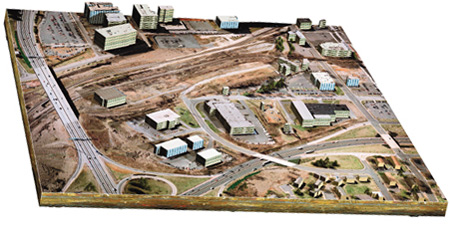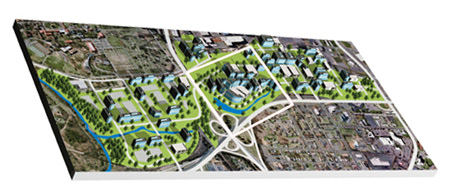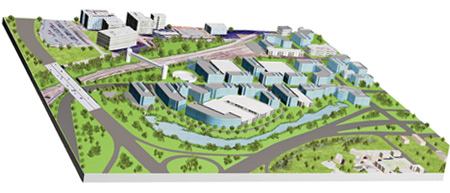Is Brown the New Green?
PIEDMONT TRIAD RESEARCH PARK
North Carolina's Wake Forest University (WFU) Health Sciences, a division of WFU Baptist Medical Center, chose to transform 230 acres of Winston-Salem's historical business district into Piedmont Triad Research Park (PTRP), a mixed-use park with a focus on life sciences and information technology.
The project is a forward-looking solution to complementary needs: While the city has suffered economic hardship over the past two decades as its homegrown tobacco and textile industries slid into decline, WFU Health Sciences has outgrown its research facilities at WFU Baptist Medical Center.
   |
The idea for this downtown mixed-use project began gaining traction in the early 1990s. Supporters believe the research park will help jumpstart the local economy by generating up to 27,000 jobs as it builds out to about 5.7 million square feet over the next several decades. Once a railroad yard, the central section is intended to become a main academic research campus for Wake Forest University. Illustrations by Don Foley |
Â
Located immediately southeast of Winston-Salem's downtown and central business districts and about two miles west of the medical center, the brownfield site was sufficiently large and close to the hospital to meet the needs of WFU Health Sciences. The local chamber of commerce was an early supporter of the idea and R.J. Reynolds (RJR) Tobacco Company expressed interest in donating one million square feet of its underutilized warehouse space to the initiative. "The whole economic structure was behind [it] to make [this] work," explains Teresa Drummond, property development coordinator at PTRP.
The 2003 master plan organizes the research park into north, central, and south districts. Research Parkway, a proposed four-lane road with ample, tree-lined sidewalks, will connect the three districts and link them to other neighborhoods. The plan identifies corridors for future mass-transit options, including an electric streetcar, for which the city is currently seeking funding, and a lightrail system that is more than a decade away. "We try to plan very far in advance," says Drummond. A 45-acre network of outdoor spaces will wind through the property, offering access to nature, biking and walking routes, and a greatly improved stormwater management system.









